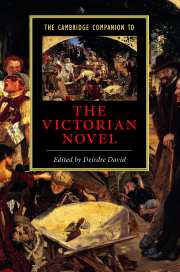Book contents
- Frontmatter
- Introduction
- 1 The Victorian novel and its readers
- 2 The business of Victorian publishing
- 3 The aesthetics of the Victorian novel: form, subjectivity, ideology
- 4 Industrial culture and the Victorian novel
- 5 Gender and the Victorian novel
- 6 Sexuality in the Victorian novel
- 7 Race and the Victorian novel
- 8 Detection in the Victorian novel
- 9 Sensation and the fantastic in the Victorian novel
- 10 Intellectual debate in the Victorian novel: religion, science, and the professional
- 11 Dickens, Melville, and a tale of two countries
- Guide to further reading
- Index
8 - Detection in the Victorian novel
Published online by Cambridge University Press: 28 May 2006
- Frontmatter
- Introduction
- 1 The Victorian novel and its readers
- 2 The business of Victorian publishing
- 3 The aesthetics of the Victorian novel: form, subjectivity, ideology
- 4 Industrial culture and the Victorian novel
- 5 Gender and the Victorian novel
- 6 Sexuality in the Victorian novel
- 7 Race and the Victorian novel
- 8 Detection in the Victorian novel
- 9 Sensation and the fantastic in the Victorian novel
- 10 Intellectual debate in the Victorian novel: religion, science, and the professional
- 11 Dickens, Melville, and a tale of two countries
- Guide to further reading
- Index
Summary
In her otherwise favorable review of Wilkie Collins's The Woman in White (i860), novelist Margaret Oliphant cautioned that novels that focused their attention upon the detection of crime as insistently as this one did represented a significant threat to the integrity of Victorian literature: “What Mr. Wilkie Collins has done with delicate care and laborious reticence, his followers will attempt without any such discretion,” she predicted. “We have already had specimens, as many as are desirable, of what the detective policeman can do for the enlivenment of literature: and it is into the hands of the literary Detective that this school of story-telling must inevitably fall at last.” Mrs. Oliphant's prophecy about the impending (if undesired) dominance of the field of Victorian fiction by the literary detective proved to be quite accurate. As she noted, several such figures had appeared on the scene already, and there would certainly be many more to come. Indeed, if we are to take The Woman in White as an example, where the detective work is carried out not by a policeman or a professional detective but by a drawing instructor who transforms himself into a collector of evidence and a solver of mysteries, the terms “detection” and “the Victorian novel” increasingly become synonymous as the nineteenth century progresses.
- Type
- Chapter
- Information
- The Cambridge Companion to the Victorian Novel , pp. 169 - 191Publisher: Cambridge University PressPrint publication year: 2000



